|
ABSTRACT: Emergency management in fixed-guideway transit systems often must confront the reality that, in single-track territories, headway is determined by trip-time. This technical briefing (a) reviews the impact of prolonged emergencies on passenger services, (b) analyzes trade-offs between trip-time and volume in single-track operations, and (c) proposes operational alternatives that may offset the requirement for capital-intensive crossovers. BACKGROUND: Passengers on light-rail, full-metro or commuter trains are familiar with occasional service delays, especially during rush-hour. Most occur at stations. A medical emergency may hold up departure for a few minutes. Responding to a security alert may take an hour or more. If the delay exceeds the headway, other trains, each possibly carrying hundreds of passengers, will be adversely affected. One door-leaf stuck open can require taking a whole train out of service. All of its passengers must then offload and wait on the platform for the next train. Meanwhile, the empty, otherwise healthy consist rejoins the normal traffic flow and continues to the nearest available pocket-track or siding and eventually to the maintenance shop. Brake lock-ups are rare. However, in the worst-case, the faulty train cannot be moved. Same for an onboard fire. The occupied platform effectively blocks normal running on the corresponding track. Dispatchers and train controllers must then invoke single-track procedures, aligning routes that permit train movements in alternating directions, sharing common trackage. Extreme cases may require setting up bus-bridges to shuttle passengers on surface streets around blocked trackage. EXECUTIVE SUMMARY: =-=-=-=-= HEADWAY
DOUBLE-TRACK HEADWAYS:
With both trackways
and all stations fully operational over a given route, headway, measured
as time between succesive are prescribed by time-table.
Headway is the mathematical reciprocal of flow-rate. On any branch
line, which supports neither divergent nor convergent services, flow-rate
must be the same at every point along the branch line, like current in
an electrical circuit. The time allowed for turn-backs at end-points
determines the stagger in the schedule for trains traveling in each direction
at any given station.
Following-move train protection, of course, will impose limits on both trip-time and headway, influenced more by the parameters of station stops than by train speed and limitations in trail-braking. For Case 0, with all interlockings aligned for Normal Running, the model estimates a through-train trip-time either NB or SB of about 9.5 min between BAS and SCS. A time-table headway of, say, 10 min means that no more than two trains (one in each direction) will be concurrently operating within the indicated territory. In Normal Running, the trackways operate independently of each other in opposite directions. We will see that single-track emergencies demand strict coordination of train movements over the common track-way. PARTIAL REVERSE RUNNING: Four operational cases are diagrammed below, depicting bad-order trains at each of the underground stations. Single-track routes are emphasized. Headways are limited by loop-times. For example, in Case 1, Normal Running NB train departing DSJ must the S55 interlocking before /// MODEL FOR ILLUSTRATION: Schematics herein depict a simplified model of a commuter rail segment for which at this writing preliminary engineering phase has been completed. The segment comprises 6.7 miles of double-track guideway, five stations (three underground), and three double crossovers. Conservative
train parameters have been chosen as follows:
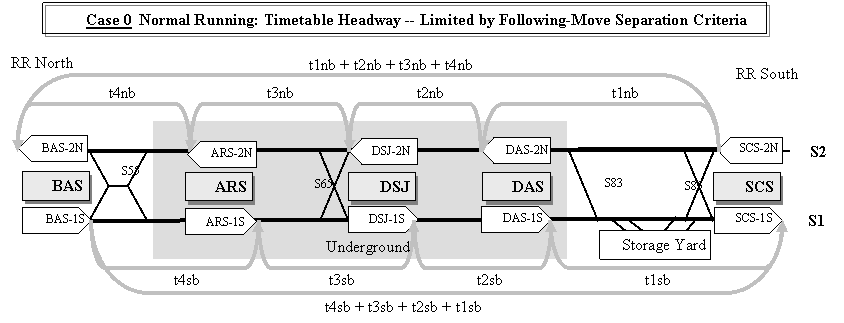 .
Each individual transit time has been modeled to include (a) accelerating out of a station at aS to vC, (b) operating between stations at vC, (c) decelerating at dS to a stop in the succeeding station, and (d) waiting out tD. It should be noted that the distance between DAS and DSJ is only 3,780 ft, which precludes operating at vC. For calculating t2nb and t2sb, a limited speed vL = 50 mph was found to be appropriate. 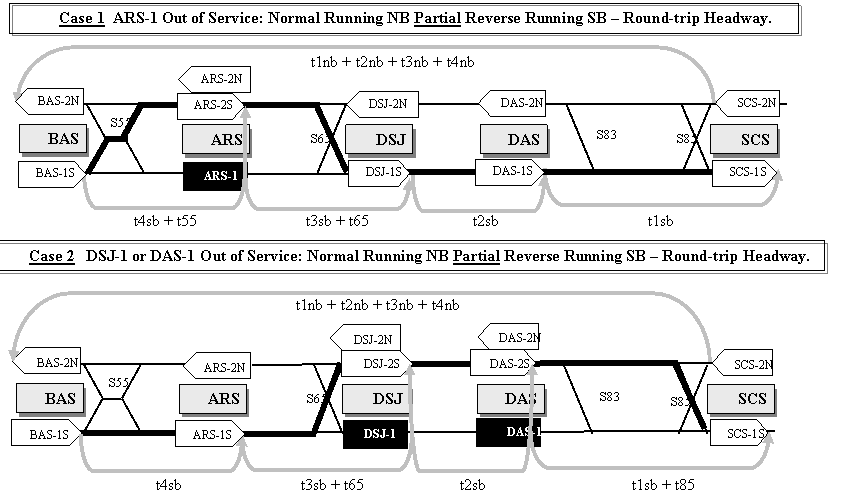 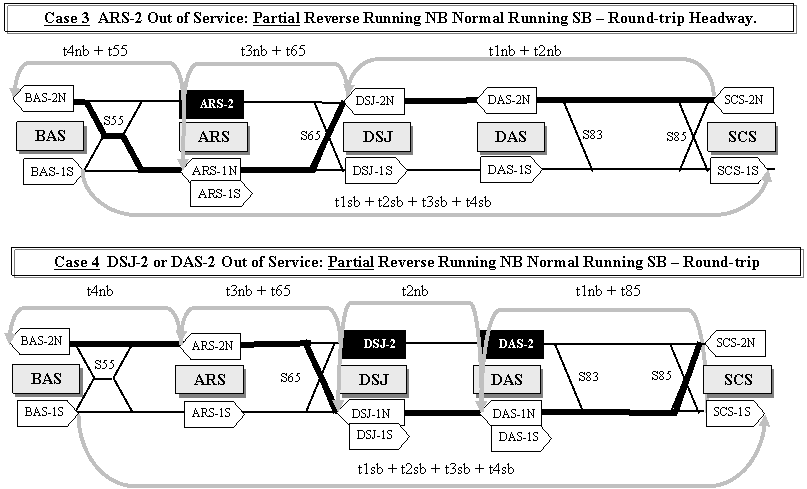
HEADING 4 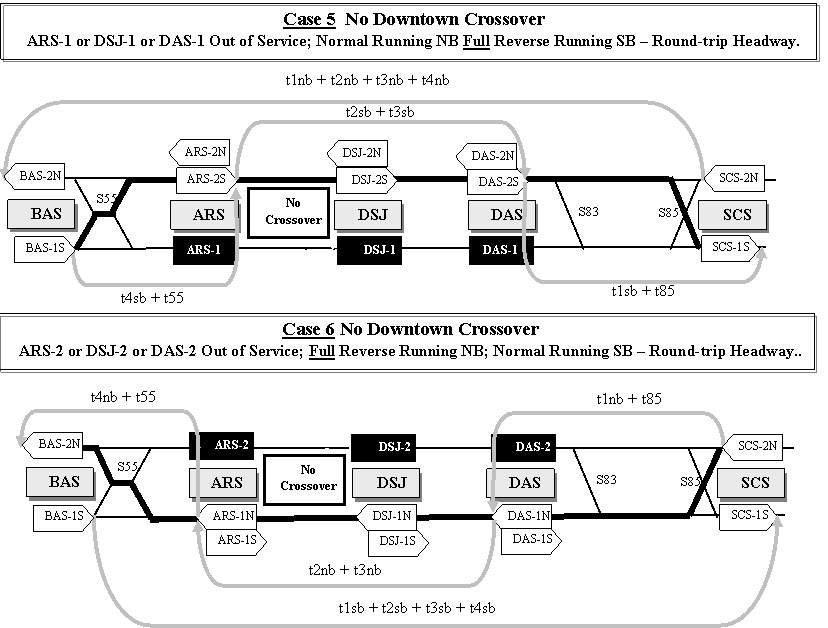
HEADING 5 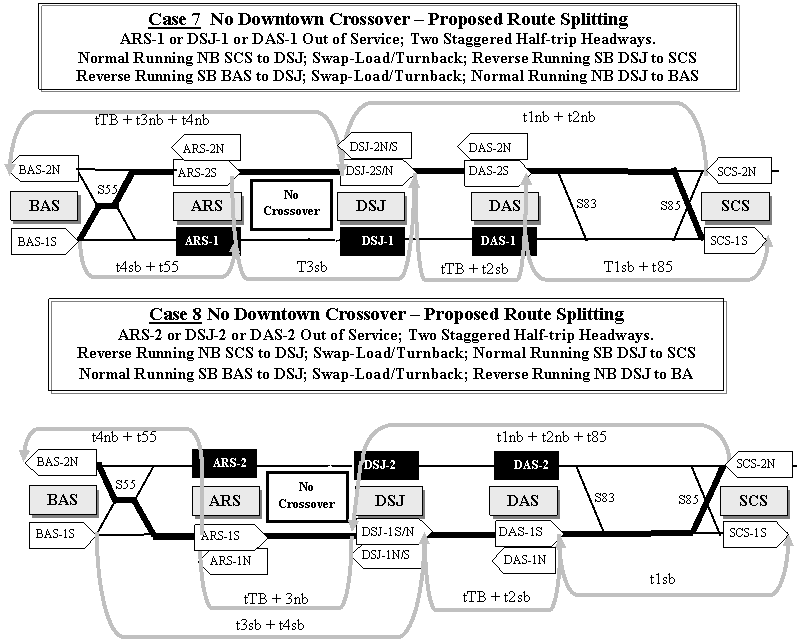 CONCLUSIONS: text
RECOMMENDATIONS: text
OPPORTUNITIES: text
REFERENCES: text
TECHNICAL BRIEFINGS by Paul Niquette: Smart Sensor Networks
in Railway Vehicles: Paper for IEEE/NIST Smart Sensor Conference, 1994
.
|